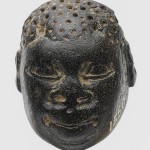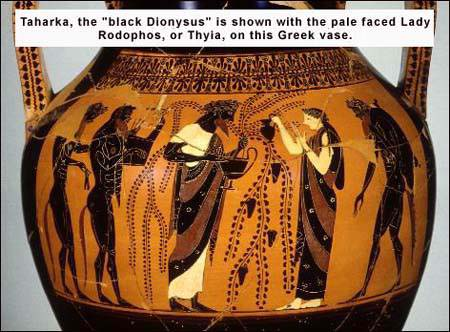
By Jide Uwechia with cited sources
The Benin Haplogroup or Haplogroup 19 Common in Africans, southern Greeks, Sicilians, and Albanians
There are at least four distinct African, (known as Senegal, Congo, Benin, Bantu Hbs Haplogroups) and one Asian chromosomal backgrounds (haplotypes) on which the sickle cell mutation has arisen.
The Benin haplotype (which originates from Nigeria, West Africa) accounts for HbS associated chromosomes in Sicily Northern Greece, Southern Turkey, and South West Saudi Arabia, suggesting that these genes had their origin in West Africa. The Asian haplotype is rarely encountered outside its geographic origin because there have been few large population movements and Indian emigrants have been predominantly from non HbS containing populations. Per:Graham R. Serjeant, MD, FRCP, The Geography Of Sickle Cell Disease:Opportunities For Understanding Its DiversityRSITY: http://www.kfshrc.edu.sa/annals/143/rev9239.html
Nigeria, west Africa appears the most logical origin of the sickle mutation in Greece evidence from beta S globin gene cluster polymorphisms (1991). It has been conclusively demonstrated that HbS in Greece is mostly haplotype #19 (the one that originated in Benin, Nigeria West Africa). See, Boussiou M, Loukopoulos D, Christakis J, Fessas P.; The origin of the sickle mutation in Greece; evidence from beta S globin gene cluster polymorphisms. Unit for Prenatal Diagnosis, Laikon Hospital, Athens, Greece.
Additionally, previous data suggest that the S/Bantu haplotype (from Southern Africa) is heterogeneous at the molecular level. Recent studies also report a similar heterogenity for the Benin Haplogroup. A study demonstrated the presence of the A -499 TA variation in sickle cell anemia chromosomes of Sicilian and North African origin bearing the S/Benin haplotype (from Nigeria). Being absent from North American S/Benin chromosomes, which were studied previously, this variation is indicative for the molecular heterogeneity of the S/Benin haplotype. Am. J. Hematol. 80:79-80, 2005.
A study was done in Albania (which borders Greece) relating to sickle cell anemia, sickle cell beta-thalassemia, and thalassemia major in Albania. The focus of the study was the characterization of sickle cell mutations. As one would expect, it was shown that the HbS mutation in the Albanian sample is the Benin (Nigeria)-originating haplotype #19. See, Boletini E, Svobodova M, Divoky V, Baysal E, Dimovski AJ, Liang R, Adekile AD, Huisman TH.; Sickle cell anemia, sickle cell beta-thalassemia, and thalassemia major in Albania: characterization of mutations. : Hum Genet. 1994 Feb;93(2):182-7.
According to a study done in 1973, before the availability of the advanced data cited above, “the occurrence of the sickle-cell trait in southern Europe …. is believed to reflect gene flow from the Middle East.” See A. P. GELPI, M.D, “Migrant Populations and the Diffusion of the Sickle-Cell Gene” August 1, 1973 vol. 79 no. 2 258-264 http://www.annals.org/content/79/2/258.abstract.
The problem with this 1973 study is that it assumes that the sickle cell genes came with the Arabs. Alas, updated research work has proven beyond doubt that the sickle cell genes proven to exist in southern Europe are exclusively Sickle cell gene Haplotype 19 or the Benin Sickle cell gene from Nigeria.
Y Haplogroup E-M78 and YAP In Black Africans and Greeks
Y Haplogroup E-M78 a derivative of E3B is a signature African gene as confirmed in research studies over the last few years. The high frequency of this haplogroup in Greece suggests the presence of a substantive African population in that region during prehistoric and historical time periods.
A recent paper has detected clades of haplogroups J and E3b that were likely not part of pre-historic migrations into Europe, but rather spread by later historical movements. Greeks .. [then there is] the marker J-M267, which may reflect more recent Middle Eastern admixture.
(Semino et al., Am J Hum Genet, 2004) E3b originates from East Africa while there is a high frequency of J-M267 in the East Coast of Africa as well as the Red sea coast of Arabia.
A recent sampling of the Greek population comprised 36 Peloponnesian samples, 5 of which were J-M172(xM12) and 17 of which were E-M78 (R.K., unpublished data).
In spite of the small Peloponnesian sample size, the high E-M78 frequency (47%) observed here is consistent with that (44%) independently found in the same region (Di Giacomo et al. 2003) for the YAP chromosomes harboring microsatellite haplotypes A. (Novelletto, personal communication) (Cruciani et al. 2004).
The study by by Di Giacomo et al. found the following African haplogroups in Greeks: Haplogroup A which is highly specific to West Africa, R1a, DE, and J2*(xDYS413= 18)J*(xJ2). R1* which probably gave rise to R1a is found in Northern Cameroon. DE is found principally among Nigerians and it is suspected that it originated from Nigeria. J is very prominent in East, and North Africa.
High-resolution Y-chromosome haplotyping and particular microsatellite associations reveal … an East Africa homeland for E-M78.Origin. See Ornella Semino, Chiara Magri, et al “Diffusion, and Differentiation of Y-Chromosome Haplogroups E and J: Inferences on the Neolithization of Europe and Later Migratory Events in the Mediterranean Area” http://www.pubmedcentral.nih.gov/articlerender.fcgi?tool=pubmed&pubmedid=15069642
HLA Genetic Relationship Between Ancient Greeks and Black Africans
HLA genes are reliable markers of past population movement and are still used in laboratories today to establish genetic inter-relationship amongst seemingly diverse peoples.
HLA genes in Macedonians and the sub-Saharan origin of the Greeks (2001) was a study conducted by Dr. Arniaz and other scholars in a top flying Spanish University. This study uses HLA genes to establish the African dimension of the roots of ancient Greece.
According to the Arniaz study, …Greeks are found to have a substantial relatedness to sub-Saharan (Ethiopian) people, which separate them from other Mediterranean groups. Both Greeks and Ethiopians share quasi-specific DRB1 alleles, such as *0305, *0307, *0411, *0413, *0416, *0417, *0420, *1110, *1112, *1304 and *1310. Genetic distances are closer between Greeks and Ethiopian/sub-Saharan groups than to any other Mediterranean group and finally Greeks cluster with Ethiopians/sub-Saharans in both neighbour joining dendrograms and correspondence analyses. The time period when these relationships might have occurred was ancient but uncertain and might be related to the displacement of Egyptian-Ethiopian people living in pharaonic Egypt. See Arnaiz-Villena A, et.al: HLA genes in Macedonians and the sub-Saharan origin of the Greeks. Tissue Antigens. 2001 Feb; 57(2): 118-27
There is a fraudulent claim (by those with idealogical investments in the topic) on the Internet that this study has been “retracted” or “refuted.” The study is perfectly valid. Sub-Saharan-specific and quasi-sub-Saharan-specific alleles were definitely detected in the Greek population at the DRB1 locus, and this is not open to question.
It would be helpful here to discuss the study that was retracted, and the reason why. It is the work titled: “The origin of Palestinians and their genetic relatedness with other Mediterranean populations” (which contained some cross-referenced Greek data in a neighbor-joining dendogram and a correspondence analysis) that was retracted. And it was retracted solely and strictly for political reasons, as this Observer article makes crystal clear:
http://www.guardian.co.uk/Archive/Article/0,4273,4307083,00.html
(Keep in mind we are dealing with the study on the relatedness of Jews and Palestinians at the moment, which was retracted, and not the one on the Greek-Black African relatedness, which was not retracted and remains valid. The two must not be confused.)
Appreciations to: http://onedroprule.org/about1071.html
Epilogue:
“Hb S is common in some areas of the Mediterranean basin, including regions of Italy, Greece, Albania and Turkey (Boletini et al., 1994) (Schiliro et al., 1990). Haplotype analysis shows that the Hb S in these areas originated in Africa. The genes probably moved along ancient trading routes between wealthy kingdoms in western Africa and the trade centers in the Mediterranean basin.” (Harvard University, http://sickle.bwh.harvard.edu/scdmanage.html)
“Usually, people with sickle cell disease outside Africa (e.g., blacks in the United States) or India have mixed haplotypes for their sickle cell genes.” (Harvard University, http://sickle.bwh.harvard.edu/scdmanage.html)
“Templeton gives a modern-day analogy: the presence of a gene for sickle cell anemia in Caucasians in Portugal. The gene traces back to a mutation that occurred in Africa and spread through interbreeding between Africans and Europeans. “The Africans didn’t come up, reconquer the Iberian peninsula, kill off all the Europeans, and that’s why there are sickle cell alleles in Portugal today,” he says. The presence of the sickle cell gene in Portugal “means that Portuguese and Africans have met and they’ve interbred, just like humans tend to do.” – “Out of Africa” – Ruth Flanagan, Contributing Editor, Earth Magazine, http://www2.mc.maricopa.edu/anthro/l…ofAfrica5.html




Cutting, pasting and misquoting what real scientist say is your speciality not mine, ignoranus. Unlike what delusional Afrocentric naive fools like yourself falsely beileve, real scientist do *NOT* over-emphasize it to the point of calling every clade and cluster “black Africanâ€, “Africanâ€, East African and or “African Neolithic†because they are not, they all have different histories as well as being different phylogeographically located and distributed differently. But given you lack of understanding what real scientists say and mean it doesn’t surprise me at all that you would misquote and misrepresent what real scientists say. Your pathetic agenda of trying to make none African people into “black Africans†has been exposed many time over.
“.. based on strong geographic structuring of diverse microsatellite motifs, E3b-M78 is suggested to be a collection of subclades with different evolutionary histories (Cruciani et al. 2004; Semino et al. 2004) out of which the cluster, largely characterized by an A7.1 nine-repeat allele, is confined to Europe (the Balkans) and Turkey (Cruciani et al. 2004). E3b1 variance distribution depicted in figure 4(D) does not overlap with its frequency distribution possibly because analyzed E3b1 chromosomes harbor diverse background motifs.â€
“Thus, it appears that, in Europe, the overall frequency pattern of the haplogroup E-M78, the most frequent E3b haplogroup in this region, is mostly contributed by a new molecular type that distinguishes it from the aboriginal E3b chromosomes from the Near East.†Am. J. Hum. Genet., 74:1014-1022, 2004
“The most parsimonious and plausible scenario is that E-V13 originated in western Asia about 11 ky ago and its presence in northern Africa is the result of a more recent introgression. Under this hypothesis, E-V13 chromosomes sampled in western Asia and their coalescence estimate detect a likely Paleolithic exit out of Africa of E-M78 chromosomes devoid of the V13 mutation, which later occurred somewhere in the Near East/Anatolia.†(Cruciani 2007)
Mr. Sickle cell is a Mosquito Virus
What is the meaning of this quote:
“Thus, it appears that, in Europe, the overall frequency pattern of the haplogroup E-M78, the most frequent E3b haplogroup in this region, is mostly contributed by a new molecular type that distinguishes it from the aboriginal E3b chromosomes from the Near East.†Am. J. Hum. Genet., 74:1014-1022, 2004
Mr. Delusional Afrocentric naive individual, what do you seriously think they mean they say: ‘A NEW MOLECULAR(hope you don’t need me to explain to you what NEW means) TYPE THAT DISTINGUISHES(DIFFERENT) IT FROM THE ABORIGINAL(NATIVE) E3B CHROMOSOMES FROM THE NEAR EAST.’
^^
Mr Comic-Tragic Mosquitoe
The above is not an explanation.
I want you to explain what “new molecular…” means in this context.
What molecule???
What is the genetic parent of this new molecule…or did it just arise by magic?
Where was this new molecule born? Where did it arise? What does that tell you of the location of the parents?
How does this molecule “Distinguish” from the aboriginal E3B? More elaboration is needed on the nature of the distinction???
What does IT refers to in that sentence?
What is the geographic locus of this comparison?
Would you mind posting the preceeding part of the quote from where you cut and pasted?
We understand that this E3B is from Africa/Near East but why is it described as Aboriginal? Aboriginal in relation to what continent? Are they the aboriginal Europeans???
Slabo wannabe-Greek making a spectacle of his ignorance, please provide some answers.
Jahdey
Jahdey, if you can’t understand what the research paper says, its doesn’t surprise me one bit that you misunderstand and misquote every other genetic scientist on this issue. ‘A NEW MOLECULAR(hope you don’t need me to explain to you what NEW means) TYPE THAT DISTINGUISHES(DIFFERENT) IT FROM THE ABORIGINAL(NATIVE) E3B CHROMOSOMES FROM THE NEAR EAST.’
They are talking about a new molecular(Genetic recombination, the process by which a strand of genetic material is broken and then joined to a different DNA molecule, it is one of the ways a gene mutated and new moleculars arise = what scientists have been proven about genetic all along = that grouping all together as ’same’ while ignoring expansion dates, different evolutionary histories (Cruciani et al. 2004; Semino et al. 2004), the geographic positioning and distribution of each clusters that mutanted is misleading and goes against what geneticists say. This new molecular that arose was different from the aboriginal molecular that arose in the NEAR EAST, not AFRICA. So not only haplogroup V13 cannot be used as an index of black African ancestry but its also different from the aboriginal E3b chromosomes from the Near East. No where does any genetic scientist ever claim the E3B alpha cluster found in Europeans is an index of black African ancestry. That is only found in the delusional minds of Afrocentric.
“.. based on strong geographic structuring of diverse microsatellite motifs, E3b-M78 is suggested to be a collection of subclades with different evolutionary histories (Cruciani et al. 2004; Semino et al. 2004) out of which the cluster, largely characterized by an A7.1 nine-repeat allele, is confined to Europe (the Balkans) and Turkey (Cruciani et al. 2004). E3b1 variance distribution depicted in figure 4(D) does not overlap with its frequency distribution possibly because analyzed E3b1 chromosomes harbor diverse background motifs.â€
http://mbe.oxfordjournals.org/…..22/10/1964
Dave continues to babble:
“They are talking about a new molecular(Genetic recombination, the process by which a strand of genetic material is broken and then joined to a different DNA molecule……..”
Jahdey roars:
Dave, what a tragedy. What a comedy. Y-DNA does not undergo re-combination. Alas this is the main usefulness of Y-DNA. It remains the same for ever save for polymorphic mutations.
Illiteracy and ignorance are the roots of your malaise. Now it has become clear to me that you are woefully inadequate to carry on this conversation with me, I would just advise you to go shut up and read some real books.
You new name is now: “Mr. Recombined Y-DNA”. LMAO!!!
GENETICS 101
The genealogical usefulness of these two DNA tests is based on some special aspects of human inheritance:
> that the Y chromosome is passed on only by the father;
> that mitochondria are passed on only by the mother, and
> that neither Y-DNA nor mtDNA engages in “recombination.”
http://dgmweb.net/genealogy/DNA/DNA-Introduction.shtml
Jahdey roar is full of ignorance as usual. Again real scientist do *NOT* over-emphasize it to the point of calling every clade and cluster “black Africanâ€, “Africanâ€, East African and or “African Neolithic†because they are not, they all have different histories as well as being different phylogeographically located and distributed differently. But given you lack of understanding what real scientists say and mean it doesn’t surprise me at all that you would misquote and misrepresent what real scientists say. Your pathetic agenda of trying to make none African people into “black Africans†has been exposed many time over. My suggestion for your naive foolishness is to actual learn how to comprehend what the research papers that you just copy/paste selectively really say because judging by your illiteracy and ignorance you have no clue.